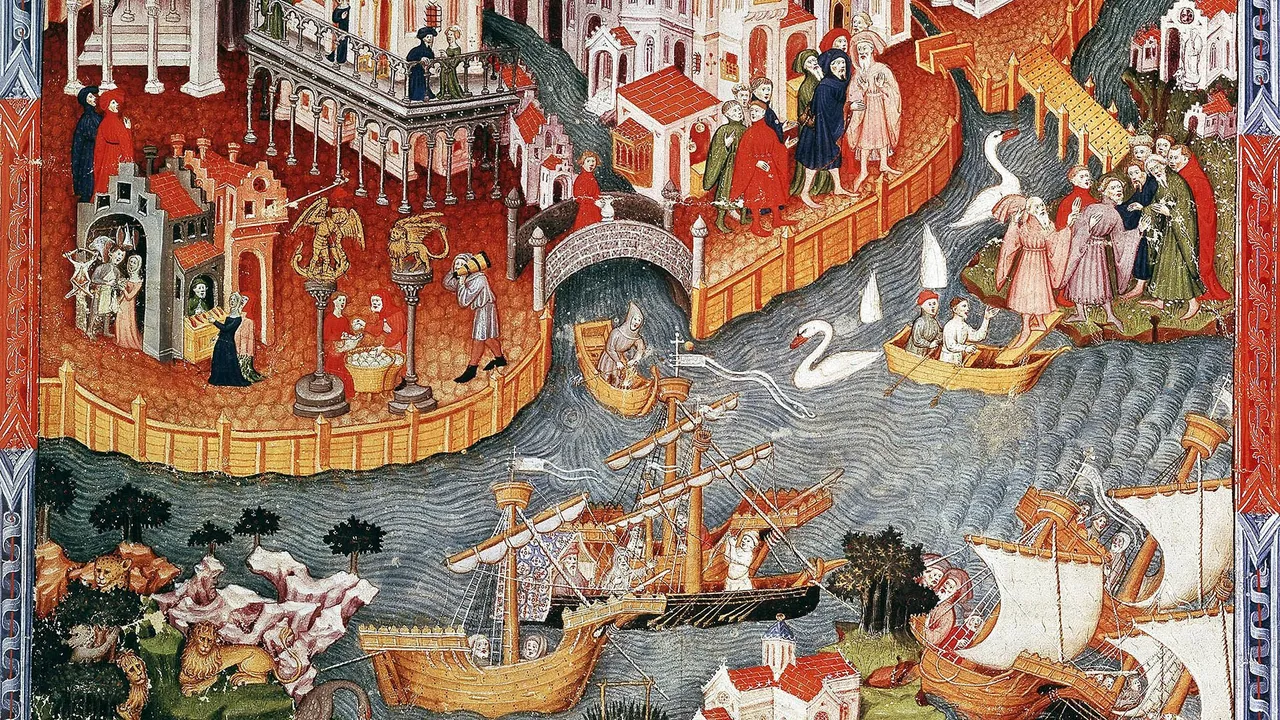When we think of travel writing, one of the oldest works in history, Marco Polo’s Book of Travels, comes to mind. Marco Polo, a Venetian merchant who traveled around the Middle East and Asia for more than a quarter of a century, is still puzzled by his accounts of the places he visited. How many of the mysterious stories Polo told are true? Here is the answer…
To what extent can you trust a person who claims to have seen a unicorn on the Indonesian island of Sumatra?
Many questions like these cast a shadow on the honesty of Marco Polo, one of the first names that comes to mind when we think of a traveler since the 14th century.
As enthusiasts know very well, Marco Polo’s Book of Travels was very popular at the time it was written, translated into many languages, and handwritten copies were placed in the libraries of European palaces.
For Polo was the first European to describe the Silk Road. His spice-scented tales were full of gold, precious stones, intriguing sexual elements and war strategies.
Thanks to all this, those who started the book couldn’t put it down before finishing it, but some of the details were so exaggerated that readers couldn’t help saying, “He’s making it up.”
Marco Polo died 700 years ago, on January 8, 1324. Since then, interest in his travelogues has never waned. What’s more, over time it became clear that this Venetian merchant and traveler was not lying about many things that sounded unbelievable.

Historian Pieralvise Zorzi told the BBC: “In those years, Venice was like New York today.” In other words, Venice was a colorful center where people from many different cultures came together and where the trade routes of East and West intersected.
The Polo family was also prominent in Venice. Marco’s father Niccolo and uncle Maffeo had a palace here and a business in Constantinople, the Istanbul of the time.
The Polos, forward-thinking people, had closed their business in Constantinople before the Greeks took control of the city and expelled the Venetians, and set off further east in search of new markets.
After a few years of trading in silk, spices, precious stones and perfumes, the brothers returned to Venice.
In 1271, 17-year-old Marco joined them on their second trip to China.
THANKS TO THE WRITER HE MET IN PRISON, HIS STORIES BECAME A BOOK
According to the book, the Polos traveled the Silk Road for three years, from the city of Acre, now in Israel, to the palace of the Mongol Emperor Kublai Khan in Khanbaliq (today’s Beijing). They traveled through the Middle East and a significant part of Central Asia. They spent roughly 20 years in China, both trading and acting as ambassadors for the state. They circumnavigated India by sea via Sumatra and the Andaman islands. They landed in the Yemeni port city of Aden, from there they traveled to Istanbul and finally to Venice.
Polo was in his 40s when they reached Venice. Legend has it that when they knocked on the door of the palace where they lived, they answered a servant’s question “Who is it?” with the local dialect “i paroni”, meaning “the owners”.
A year after this incident, Marco Polo was in prison. He had been captured in a war between the two rival naval powers of the time, the Venetians and the Genoese.
Here Polo met the writer and editor Rustichello da Pisa. Da Pisa immediately recognized the literary potential of the world described by the man in front of him, a world almost unknown to Europeans. They therefore decided to transcribe Polo’s stories.

THE ORIGINAL BOOK HAS DISAPPEARED
The book became an instant hit. The manuscript was so delightful that it was soon reproduced many times and translated into many languages. In the intervening centuries, Marco Polo’s travelogue became the perfect puzzle for linguists. Because the original book was lost. All that was left were translations based on translations, and none of them were completely accurate.
Eugenio Burgio, who has been studying the Marco Polo corpus for over 40 years at the University of Venice Ca’ Foscari, gave the following example of the book’s journey: “A French version was first translated into an Italian dialect used between Emilia-Romagna and Veneto. This translation was then revised in the Tuscan dialect. Based on this version, a Latin translation was made. How close can this Latin text be to the original?”
The question is difficult to answer, but Burgio and his colleagues plan to publish the philologically complete version of Marco Polo’s Book of Travels later this year. The book highlights the most plausible possibilities among the different versions.
“Linguists don’t admit it, but they dream of being like Indiana Jones, of unearthing treasures,” Burgio said, noting that his work on Marco Polo’s travelogue is a very good example of this dream.
Just as the original version of Polo’s book was lost, his family’s palace in Venice was destroyed in a fire in the 16th century. Today, six different buildings are claimed to be Polo’s home. The stone of Polo’s tomb in the garden of the Church of San Lorenzo is also missing. Moreover, there is no monument dedicated to him. “It’s a curse,” said academic Tiziana Plebani, who spent 10 years of her life studying Polo and his deathbed will.
WHY DOESN’T HE TALK ABOUT TEA? WHY DOESN’T HE SPEAK CHINESE?
There is no tangible legacy left from Polo, and the authenticity of his stories has been debated for centuries. Did he really go to China? If he did, why did he never mention tea or the Great Wall of China in his book? Why did he trade in the region for a quarter of a century and yet he could not speak a word of Chinese?
Some of these questions have been asked since the Middle Ages. Only recently have experts agreed that there may be reasonable answers to these questions.
Burgio, for example, said it was not surprising that Polo’s travelogue did not mention tea: “Tea drinking is something that Anglo-Saxon historians are obsessed with. Why would Marco care about that?” Moreover, according to experts, those who ruled China at the time did not speak Chinese. Moreover, as Zorzi points out, the construction of the Great Wall had not yet been completed.
Moreover, there are official documents indicating that Polo actually made his travels. After the death of her husband, Polo’s daughter Fantina applied to the court and demanded the return of the dowry she had given him at their marriage. The dowry in question included a gold passport given to Marco Polo by Kublai Khan. This precious tablet meant that Polo traveled under Kublai Khan’s patronage. Moreover, Polo was able to describe things like China’s monetary system in great detail.
All this points to the fact that Polo actually traveled to China. However, experts believe that the accounts of his ambassadorial mission are exaggerated and that Polo made himself seem more important than he really was.

HE LEFT HIS LEGACY TO HIS WIFE AND DAUGHTERS
On the other hand, there are other interesting details in Fantina’s story. For example, the fact that Polo went against the traditions of the time and left all his property to his wife and daughters is interpreted as a feminist. “True, he could not leave his fortune to his sons or brothers because he had neither sons nor brothers. But she could have called more distant male relatives if she wanted to,” Plebani said:
“That means this: Either he was not good with the men in his family or he really cared and respected his wife and daughters. This makes sense to me because once Venetian merchants left the city, they wouldn’t return for years, everything in the house was entrusted to women.”
On the other hand, despite being a medieval man, Polo, without judging in any way the matriarchal traditions of Tibet or India’s Women’s Island, described Tatar women and girls riding horses “just like men”.
HE WAS ENTHUSIASTIC ABOUT MELONS AND CHICKENS
Polo’s interests were very diverse. According to Burgio, he also described the sexual habits of concubines and a different type of chicken whose body was covered with fur instead of feathers. He not only wrote about the “melons sweeter than honey” he saw in Sapurgan (now Shibirgan in Afghanistan), but also about the Malabar region in southern India, where people had the custom of washing before eating and eating only with their right hand. He admired Kublai Khan’s wisdom and noted that thanks to the trees he had planted along the roadsides, travelers could not only get lost but also rest in the shade.
Zorzi recalled that this was the first time Polo had ever been outside Venice, adding: “It’s a beautiful and open world seen through the eyes of a teenager. Everything is so new and so interesting that he was able to record it in his head.”
Stating that today’s world is much smaller, Burgio said, “Because there are almost no unexplored corners left. Polo lived in a time when there was so much to discover and it seems that he saw humanity as a whole. He commented that ‘people may behave differently from us, but their reasons are the same as ours’.”
“He teaches us to be open, to be more curious and more willing to engage with other cultures,” Plebani said of Polo, whom he described as an “ambassador of peace and curiosity.”

SALAMANDER THAT DOESN’T BURN IN FIRE, UNICORN
Speaking of curiosity, were the mythological animals Polo claimed to have seen real?
One of the creatures in Polo’s book is a legendary medieval salamander with the power to live in fire. Polo states that he saw this salamander in ‘Chingitalas’ in northern China and emphasizes that it is not an animal.
What Polo described as a refractory substance with thin wires, we know today as asbestos.
As for the unicorn, Polo notes that this animal’s horn is thick and black, and that its head, which resembles the head of a wild boar, always points towards the ground. This creature, which Polo says loves mud and is “very ugly”, is of course none other than the animal we know today as the rhinoceros…
Extracted from the BBC report “The Travels of Marco Polo: The true story of a 14th-Century bestseller”.





